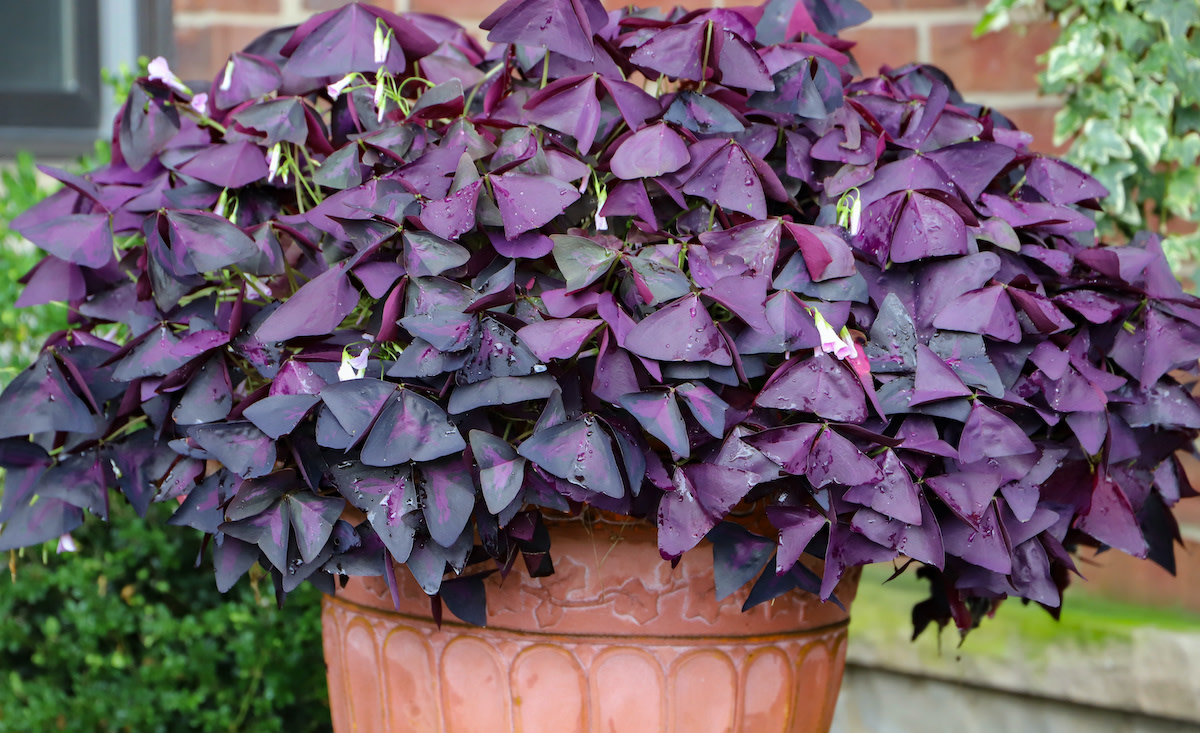How to Grow and Care for Purple Oxalis in Your Garden
Written by MasterClass
Last updated: Aug 19, 2021 • 4 min read
Commonly known as false shamrock or purple shamrock, purple oxalis is a perennial plant that grows dark purple leaves that are almost black. Learn more about the properties of this plant, and how you can plant it in your own garden.
Learn From the Best
What Is Purple Oxalis?
Purple oxalis (common name for Oxalis triangularis) is an herbaceous perennial plant. Also known as false shamrock or purple shamrock plant, purple oxalis has deep purple, heart-shaped leaflets that grow in clusters of three. Clumps of small pink flowers or white flowers bloom from the purple oxalis plant.
During the nighttime or on dark and cloudy days, purple oxalis leaves will fold downwards and form an umbrella-like shape before reopening in the morning light. Purple oxalis is native to South America and does best in warm climates seen in USDA hardiness zones 8 through 11. It is often grown indoors as a houseplant in cooler climates.
When to Plant Purple Oxtails
The best time to plant purple oxalis is in the early spring after the last frost has passed. When you grow purple oxalis outdoors, it tends to bloom in the late spring before a short dormancy period in the summer. Purple oxalis will bloom again when fall brings cooler weather. Purple oxalis may grow throughout the summer when it is grown as an indoor plant.
How to Grow Purple Oxalis
Purple oxalis is easy to grow under the right conditions. Plus, it can add a unique splash of dark purple foliage to your garden. The propagation of new plants happens through a bulb rather than a seed for this plant. Follow the simple steps below for how to use Oxalis triangularis bulbs to grow purple oxalis.
- 1. Pick your spot. Find a spot in your garden with well-draining soil that gets four hours of full sun a day, but also partial shade. If you live in a particularly warm or dry climate, prioritize shade to prevent your plant from burning in the direct sunlight of hot afternoons.
- 2. Dig your holes. Dig a hole about two inches deep in your prepared soil that is the width of your oxalis bulb. If you’re planting multiple bulbs, space your plants three or four inches apart.
- 3. Plant your bulbs. Place one bulb in each hole and cover with potting soil. Gently tamp down the dirt. Water immediately after you plant your bulb.
- 4. Water lightly. Water your bulbs about once a week until you notice new growth emerging from your bulb. During active growth seasons (springtime and autumn), you should water whenever the top inch or two of soil feels dry. Your purple oxalis should begin to show new growth in about four weeks.
6 Care Tips for Purple Oxalis
Purple oxalis can be an easy, low-maintenance plant when grown in the right conditions. Follow these plant care tips to keep your oxalis thriving.
- 1. Bring your plants indoors during the winter months. Purple oxalis is dormant in the winter, but will still need some basic care to keep it healthy for the next growing season. Dig up your plants and store them indoors before the first frost of fall to keep your plants thriving year-round. If your plant wilts, this may mean that it is going dormant. Stop watering or feeding your plant during its dormancy. After the last frost of spring has passed, you can bring your plants back outdoors and resume watering.
- 2. Fertilize once a month. Apply a diluted, slow-release liquid fertilizer to your plant once a month during the growing seasons. Do not fertilize your plant during its dormant months.
- 3. Prune once a year. Prune away dead foliage before your plant enters its dormant periods (summer and winter).
- 4. Choose the right soil. Loamy soil is ideal for purple oxalis, but any well-draining sandy soil mix should be healthy for the plant. If you’re growing your plant in a container, choose a standard, lightweight potting mix with good drainage.
- 5. Water in moderation. Overwatering can lead to root disease, especially if the soil doesn’t drain properly. A buildup of powdery mildew or rust may be a sign of fungal disease caused by root rot.
- 6. Keep an eye out for pests. Spider mites, aphids, and mealybugs are the three most common pests that infest purple shamrock. Treat them with an insecticidal spray (or neem oil) applied to both sides of the leaves as well as the stems.
Is Purple Oxalis Toxic?
Purple oxalis is considered toxic to animals and humans. The plant contains oxalic acid, which can interfere with the body’s digestion and affect the kidneys of people who have arthritis, gout, or are susceptible to kidney stones. Large quantities of oxalic acid can also inhibit calcium absorption in humans as well as house pets. When keeping purple oxalis as a houseplant, keep it out of reach from cats and dogs due to its toxicity.
Learn More
Grow your own garden with Ron Finley, the self-described "Gangster Gardener." Get the MasterClass Annual Membership and learn how to cultivate fresh herbs and vegetables, keep your house plants alive, and use compost to make your community—and the world—a better place.
